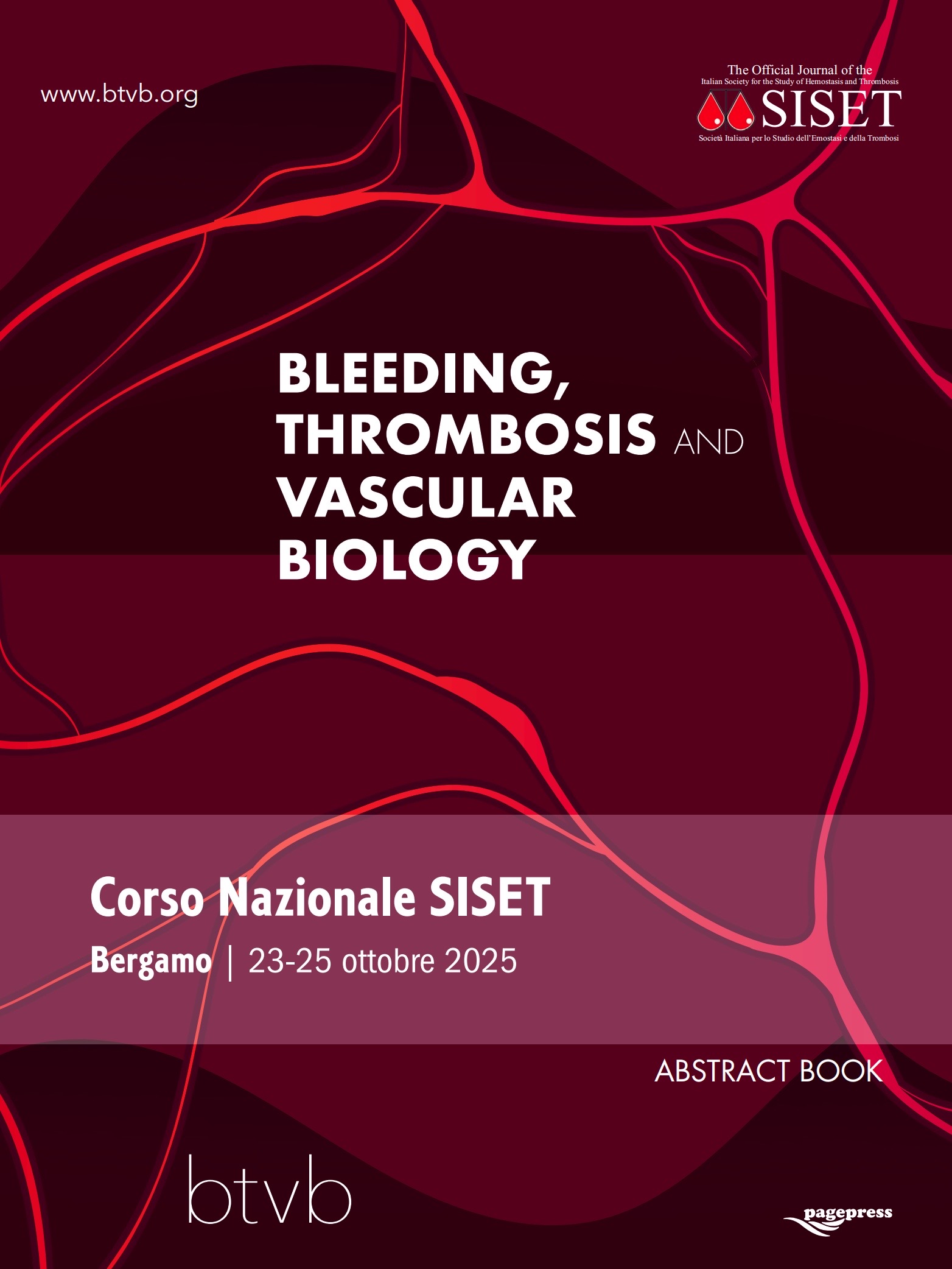29th National Conference of the Italian Society for the Study of Hemostasis and Thrombosis, 2025
Vol. 4 No. s1 (2025)
CS08 | A combination of two rapid immunoassays improves HIT diagnosis
G. Ciarrocca Taranta1, A. Rogolino2, A. Bertelli1, A. Sorrentino1, M. Di Gioia2, F. Cesari2, B. Giusti1,2, E. Sticchi1,2, M. Berteotti1,2, A.M. Gori1,2, R. Marcucci1,2 | 1Department of Experimental and Clinical Medicine, University of Firenze; 2Atherothrombotic Disease Unit, Careggi University Hospital, Firenze, Italy
Publisher's note
All claims expressed in this article are solely those of the authors and do not necessarily represent those of their affiliated organizations, or those of the publisher, the editors and the reviewers. Any product that may be evaluated in this article or claim that may be made by its manufacturer is not guaranteed or endorsed by the publisher.
All claims expressed in this article are solely those of the authors and do not necessarily represent those of their affiliated organizations, or those of the publisher, the editors and the reviewers. Any product that may be evaluated in this article or claim that may be made by its manufacturer is not guaranteed or endorsed by the publisher.
Published: 22 October 2025
50
Views
0
Downloads
Similar Articles
- Guest Editor: Valerio De Stefano, Course President, 29th National Conference of the Italian Society for the Study of Hemostasis and Thrombosis, 2025 , Bleeding, Thrombosis and Vascular Biology: Vol. 4 No. s1 (2025)
- CS07 | Endothelial dysfunction and impaired angiogenesis in Hermansky-Pudlak syndrome (HPS) type 1: studies with endothelial colony forming cells , Bleeding, Thrombosis and Vascular Biology: Special issues
- Roger Lijnen, Désiré Collen, The key to fibrinolysis and thrombolysis , Bleeding, Thrombosis and Vascular Biology: Vol. 4 No. 3 (2025)
- Bianca Clerici, Mariangela Scavone, Gian Marco Podda, Recent advances in classic heparin-induced thrombocytopenia (HIT), autoimmune HIT, spontaneous HIT, and vaccine-induced immune thrombotic thrombocytopenia , Bleeding, Thrombosis and Vascular Biology: Vol. 3 No. 2 (2024)
- CO44 | First interlaboratory validation workshop of immunofluorescence microscopy on the peripheral blood smear for recognizing patients with inherited platelet disorders , Bleeding, Thrombosis and Vascular Biology: Vol. 4 No. s1 (2025)
- Luca Puccetti, Vincenzo Sammartano, Federico Caroni, Margherita Malchiodi, Paola Calzoni, Eleonora Franceschini, Lucrezia Galasso, Monica Bocchia, Safety of COVID-19 mRNA vaccination in patients with history of acquired hemophilia A: a case series , Bleeding, Thrombosis and Vascular Biology: Vol. 1 No. 3 (2022)
- PO03 | Enlarged platelets with reduced GP IB/IX can indicate disorders other than Bernard-Soulier syndrome , Bleeding, Thrombosis and Vascular Biology: Vol. 4 No. s1 (2025)
- Marcello Di Nisio, Matteo Candeloro, Nicola Potere, Ettore Porreca, Jeffrey I. Weitz, Factor XI inhibitors: a new option for the prevention and treatment of cancer-associated thrombosis , Bleeding, Thrombosis and Vascular Biology: Vol. 3 No. s1 (2024)
- Rita Carlotta Santoro, Roberto Minici, Marzia Leotta, Mariapia Falbo, Lucia Concetta Elia, Francesca Leo, Antonella Ierardi, Alessandra Strangio, Simona Prejanò, Vaccine-induced immune thrombotic thrombocytopenia following ChAdOx1 nCoV-19 vaccine: report of two cases , Bleeding, Thrombosis and Vascular Biology: Vol. 1 No. 2 (2022)
- Luca Barcella, Chiara Ambaglio, Paolo Gritti, Francesca Schieppati, Varusca Brusegan, Eleonora Sanga, Marina Marchetti, Luca Lorini, Anna Falanga, Long-term persistence of high anti-PF4 antibodies titer in a challenging case of AZD1222 vaccine-induced thrombotic thrombocytopenia , Bleeding, Thrombosis and Vascular Biology: Vol. 2 No. 2 (2023)
1-10 of 134
Next
You may also start an advanced similarity search for this article.








